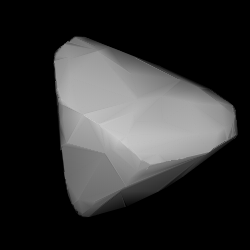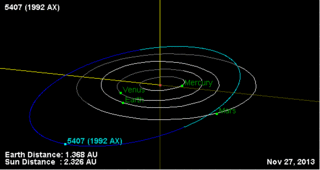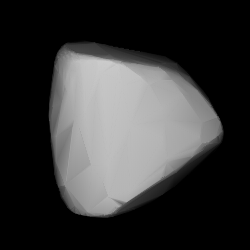106 Dione is a large main-belt asteroid. It probably has a composition similar to 1 Ceres. It was discovered by J. C. Watson on October 10, 1868, and named after Dione, a Titaness in Greek mythology who was sometimes said to have been the mother of Aphrodite, the Greek goddess of love and beauty. It is listed as a member of the Hecuba group of asteroids that orbit near the 2:1 mean-motion resonance with Jupiter. The orbital period for this object is 5.66 years and it has an eccentricity of 0.17.

128 Nemesis is a large 180 km main-belt asteroid, of carbonaceous composition. It rotates rather slowly, taking about 78 hours to complete one rotation. Nemesis is the largest member of the Nemesian asteroid family bearing its name. It was discovered by J. C. Watson on 25 November 1872, and named after Nemesis, the goddess of retribution in Greek mythology.

233 Asterope is a large main-belt asteroid that was discovered on 11 May 1883, by French astronomer Alphonse Borrelly at Marseille Observatory in Marseille, France. The asteroid was named after Asterope, one of the Pleiades.

283 Emma is a large asteroid of the asteroid belt and the namesake of the Emma family. It was discovered by Auguste Charlois on 8 February 1889, in Nice, France. The reason for its name is unknown.

(55565) 2002 AW197 (provisional designation 2002 AW197) is a classical, non-resonant trans-Neptunian object from the Kuiper belt in the outermost region of the Solar System, also known as a cubewano. With a likely diameter of at least 600 kilometers (400 miles), it is approximately tied with 2002 MS4 and 2013 FY27 (to within measurement uncertainties) as the largest unnamed object in the Solar System. It was discovered at Palomar Observatory in 2002.
716 Berkeley is a background asteroid from the central regions of the asteroid belt. It was discovered by Austrian astronomer Johann Palisa at the Vienna Observatory on 30 July 1911. The stony S-type asteroid has a rotation period of 15.6 hours and measures approximately 21 kilometers in diameter. It was named after the city of Berkeley, California, where the discoverer's colleague Armin Otto Leuschner (1868–1953) was the director of the local observatory.

748 Simeïsa is a very large Hilda asteroid from the outermost regions of the asteroid belt, approximately 104 kilometers in diameter. It was discovered on 14 March 1913, by Russian astronomer Grigory Neujmin at the Simeiz Observatory on the Crimean peninsula. The dark P-type asteroid has a rotation period of 11.9 hours and a shape that is reminiscent of a tetrahedron. It was the first asteroid discovery made in Russia and named after the discovering observatory and its nearby Crimean town, Simeiz.
956 Elisa is a Flora asteroid from the inner regions of the asteroid belt, approximately 10.5 kilometers in diameter. It was discovered on 8 August 1921, by German astronomer Karl Reinmuth at the Heidelberg Observatory. The V-type asteroid has a rotation period of 16.5 hours. It was named after Elisa Reinmuth, mother of the discoverer.
4674 Pauling, provisional designation 1989 JC, is a spheroidal binary Hungaria asteroid from the innermost regions of the asteroid belt, approximately 4.5 kilometers in diameter. It was discovered by American astronomer Eleanor Helin at the U.S. Palomar Observatory, California, on 2 May 1989, and named after the American chemist and Nobel laureate Linus Pauling.
1065 Amundsenia, provisional designation 1926 PD, is a stony asteroid and sizeable Mars-crosser on an eccentric orbit from the inner asteroid belt, approximately 10 kilometers in diameter. It was discovered on 4 August 1926, by Soviet astronomer Sergey Belyavsky at the Simeiz Observatory on the Crimean peninsula. The asteroid was named after Norwegian polar explorer Roald Amundsen.
(35671) 1998 SN165 (provisional designation 1998 SN165) is a trans-Neptunian object from the Kuiper belt located in the outermost region of the Solar System. It was discovered on 23 September 1998, by American astronomer Arianna Gleason at the Kitt Peak National Observatory near Tucson, Arizona. The cold classical Kuiper belt object is a dwarf planet candidate, as it measures approximately 400 kilometers (250 miles) in diameter. It has a grey-blue color (BB) and a rotation period of 8.8 hours. As of 2021, it has not been named.
2744 Birgitta, provisional designation 1975 RB, is a stony asteroid and a Mars-crosser on an eccentric orbit from the innermost regions of the asteroid belt, approximately 3 kilometers in diameter. It was discovered at the Kvistaberg Station of the Uppsala Observatory in Sweden on 4 September 1975, by Swedish astronomer Claes-Ingvar Lagerkvist, who named it after his daughter, Anna Birgitta Angelica Lagerkvist. The S-type asteroid has a rotation period of 9.0 hours.
1240 Centenaria, provisional designation 1932 CD, is a background asteroid from the outer regions of the asteroid belt, approximately 60 kilometers in diameter. It was discovered on 5 February 1932, by astronomer Richard Schorr at the Bergedorf Observatory in Hamburg, Germany. The assumed C-type asteroid has a rotation period of 11.3 hours. It was named for the 100th anniversary of the discovering observatory.
9069 Hovland, provisional designation 1993 OV, is a stony binary Hungaria asteroid from the inner regions of the asteroid belt, approximately 3 kilometers in diameter.
15350 Naganuma, provisional designation 1994 VB2, is a stony background asteroid from the inner regions of the asteroid belt, approximately 4.3 kilometers (2.7 miles) in diameter. It was discovered on 3 November 1994, by Japanese astronomers Yoshio Kushida and Osamu Muramatsu at the Yatsugatake South Base Observatory. The likely S-type asteroid has a rotation period of 2.5 hours. It was named for the town of Naganuma in northern Japan.
6244 Okamoto, provisional designation 1990 QF, is a background asteroid and binary system from the inner regions of the asteroid belt, approximately 5 kilometers in diameter. It was discovered on 20 August 1990, by Japanese astronomer Tsutomu Seki at the Geisei Observatory in Kōchi, Japan, and later named after Japanese school teacher Hiroshi Okamoto. The presumed S-type asteroid has a short rotation period of 2.9 hours. The discovery of its minor-planet moon was announced in October 2006.
1235 Schorria, is a Hungaria asteroid, sizable Mars-crosser, and exceptionally slow rotator from the inner region of the asteroid belt. The carbonaceous C-type asteroid has an outstandingly long rotation period of 1265 hours and measures approximately 5.5 kilometers kilometers in diameter. It was discovered by Karl Reinmuth at Heidelberg Observatory in southwest Germany on 18 October 1931, and named after German astronomer Richard Schorr (1867–1951).
2513 Baetslé, provisional designation 1950 SH, is a stony Flora asteroid from the inner regions of the asteroid belt, approximately 16 kilometers in diameter.

(5407) 1992 AX, provisional designation 1992 AX, is a stony asteroid and a synchronous binary Mars-crosser from the innermost region of the asteroid belt, approximately 3.6 kilometers in diameter. It was discovered on 4 January 1992, by Japanese astronomers Seiji Ueda and Hiroshi Kaneda at the Kushiro Observatory on Hokkaidō, Japan. The S-type asteroid has a short rotation period of 2.5 hours. Its sub-kilometer satellite was discovered in 1997. As of 2018, the binary system has not been named.
(444030) 2004 NT33 is a classical trans-Neptunian object and possible dwarf planet of the Kuiper belt in the outermost region of the Solar System, approximately 450 kilometers in diameter. It was discovered on 13 July 2004, by astronomers at Palomar Observatory, California, United States.






